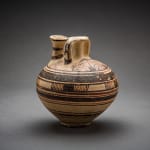Mycenaean period terracotta stirrup jar, 13 Century BCE - 12th Century BCE
Terracotta
height 12.7 cm
height 5 in
height 5 in
X.0289
Further images
The Mycenaean civilization was the last phase of the Bronze Age in Ancient Greece (ca. 1600–1100 BC). It represents the first advanced civilization in mainland Greece, characterised by palatial states,...
The Mycenaean civilization was the last phase of the Bronze Age in Ancient Greece (ca. 1600–1100 BC). It represents the first advanced civilization in mainland Greece, characterised by palatial states, urban organization, refined works of art and a writing system. Among the centers of power that emerged, the most notable were those of Pylos, Tiryns, Midea in the Peloponnese, Orchomenos, Thebes, Athens in Central Greece and Iolcos in Thessaly. The most prominent site was Mycenae, in Argolid, to which the culture owes its name. Mycenaean and Mycenaean-influenced settlements also appeared in Epirus, Macedonia, on islands in the Aegean Sea, on the coast of Asia Minor, the Levant, Cyprus and Italy.
The shape takes its name from the configuration of the high, narrow spout and the two strap handles attached to the neck. The centre of the handle was often decorated to look like a spout whereas the true spout was in fact to the side and separate from the handle. Stirrup jars had first appeared on Crete in the 16th century BC but they became much more common from the 14th century BC. Such jars came in all sizes and were usually used to transport and store liquids, such as wine and oils.
The Mycenean aesthetic relies upon using decorative elements to enhance and emphasize the shape of the vessel. It is for this reason that the principle decoration zone is reserved for the shoulder, with sets of elaborate triangles and semi-circular motifs. The profile and decoration of this vase find their closest parallels in a similar stirrup vessel discovered in Tomb 115 of the cemetery of Armenoi, now in the collections of the Rethymnon Museum on Crete, dated to the Late Mycenean III B Period, ca. 1340 to 1190 BC.
Ministry of Culture, Hellenic Cultural Heritage S.A. Cultural Olympiad 2001-2002, Minoans and Myceneans. Flavours of Their Time (Athens 2002), page 60, catalogue 33, for the parallel in the Rethymnon Museum.
The shape takes its name from the configuration of the high, narrow spout and the two strap handles attached to the neck. The centre of the handle was often decorated to look like a spout whereas the true spout was in fact to the side and separate from the handle. Stirrup jars had first appeared on Crete in the 16th century BC but they became much more common from the 14th century BC. Such jars came in all sizes and were usually used to transport and store liquids, such as wine and oils.
The Mycenean aesthetic relies upon using decorative elements to enhance and emphasize the shape of the vessel. It is for this reason that the principle decoration zone is reserved for the shoulder, with sets of elaborate triangles and semi-circular motifs. The profile and decoration of this vase find their closest parallels in a similar stirrup vessel discovered in Tomb 115 of the cemetery of Armenoi, now in the collections of the Rethymnon Museum on Crete, dated to the Late Mycenean III B Period, ca. 1340 to 1190 BC.
Ministry of Culture, Hellenic Cultural Heritage S.A. Cultural Olympiad 2001-2002, Minoans and Myceneans. Flavours of Their Time (Athens 2002), page 60, catalogue 33, for the parallel in the Rethymnon Museum.
Provenance
The Heidi Vollmoeller Collection, Acquired in 1978.Christie's, Sale #9722, THE HEIDI VOLLMOELLER COLLECTION, Lot #522, London, South Kensington, 29 October 2003





